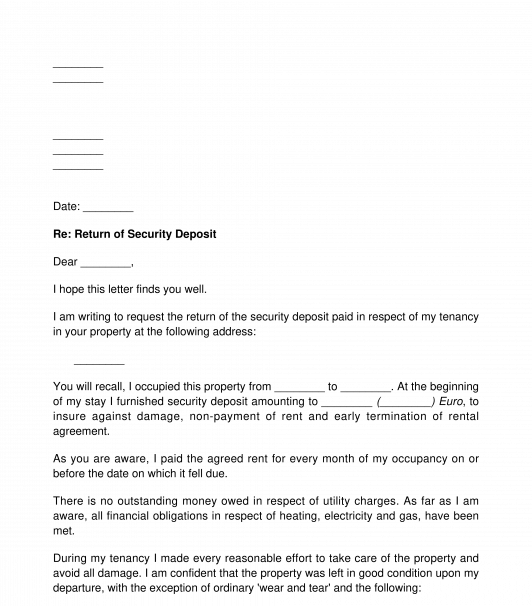 13/01/2025
13/01/2025

Answer a few questions and your document is created automatically.

Your document is ready! You will receive it in Word and PDF formats. You will be able to modify it.

 13/01/2025
13/01/2025
 Word and PDF
Word and PDF
 1 to 2 pages
1 to 2 pages
This document serves to facilitate tenants in requesting the refund of a security deposit furnished at the start of a rental period. A security deposit is a sum of money amounting to one or two month's rent, paid by a tenant to their landlord at the start of their tenancy in addition to payments of monthly rent and bills.
The deposit is held by the landlord as security in the rare event that the tenant fails to pay the agreed rent or bills, leaves the tenancy without notice or does physical damage to the property going beyond normal wear and tear. Landlords are supposed to return tenants' deposits promptly upon their vacating the property, typically within 14 days. A deposit can only be withheld if there are objective reasons to do so, specifically: non payment, withdrawal from lease or damage. In the absence of an objective reason to withhold the deposit, the landlord must return it to the tenant as soon as possible.
This letter is designed to support tenants in requesting the full or partial refund of their security deposit. It can be used whether the refund of the deposit is late, or simply to remind the landlord of their obligation to do so in advance of or upon vacating the property. This document allows the user to state why the refund of the deposit is necessary, by including all the legally relevant factors determining if a deposit ought to be returned. The user can indicate whether or not they, paid their rent in full, paid all bills in full and if any damage to the property occurred during their tenancy. In the event that some damage was done to the property, or there exists some arrears, the tenant can request a partial refund of their deposit, less the cost of any repairs or rental arrears. The deposit is supposed to act as security, not a means of enriching the landlord.
This document is presented in a formal and professional format to reflect the essentially legal nature of this correspondence, which ultimately can have significant financial consequences.
How to Use this Document
This document can be used by any tenant seeking a partial or full return of a security deposit paid in respect of a rented property. It can be used preemptively, to remind landlord's of their obligation to promptly refund the deposit, or if the landlord has failed to return the deposit when the tenant has vacated the property. Two weeks is considered the maximum reasonable grace period for landlords to inspect the property, assess any damages and arrange their finances so they can refund the deposit. Beyond this point, the return of the deposit is considered late and gives rise to potential liability on behalf of the landlord.
If a landlord determines that they are entitled to retain the deposit for damages or arrears, they should inform the tenant of the basis of their decision. If the tenant disputes this finding, legal advice can be sought through a number of reputable Irish housing charities. It is strongly advised that tenants don't let too much time pass between vacating the property and requesting a refund of the deposit through this letter. Moreover, it is advised that the user retain a hard and soft copy of this document for their personal files. Evidence of this communication will be very important in the unfortunate event of a dispute with the landlord over the deposit's return. Though there is always a risk of dispute, this letter is designed to clearly and effectively communicate the tenant's position and their legal rights, forthrightness and professionalism in communication go a long way to avoid disputes.
Applicable Law
This document has been written to incorporate the law governing landlord and tenant relations and property leasing in Ireland. Specifically: The Residential Tenancies (No. 2) Act 2021, the Residential Tenancies (Amendment) Act 2019, these statutes operate to amend the Residential Tenancies Act 2004.
This document also observes the recommendations of housing charities, such as Threshold, whose guidelines are endorsed by the Irish state.
How to modify the template
You fill out a form. The document is created before your eyes as you respond to the questions.
At the end, you receive it in Word and PDF formats. You can modify it and reuse it.
Letter Requesting Return of Tenancy Deposit - template
Country: Ireland